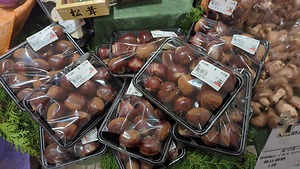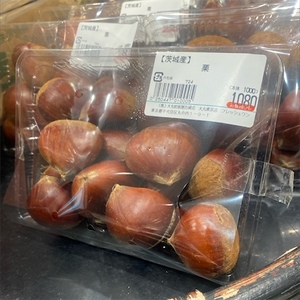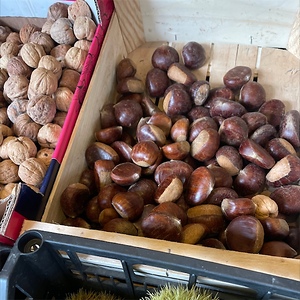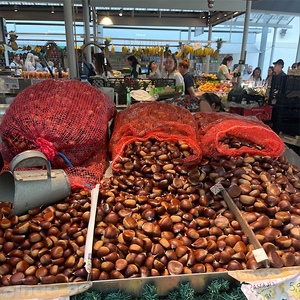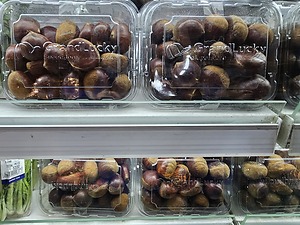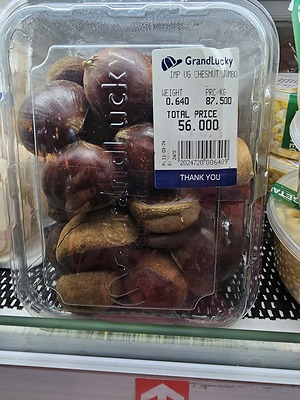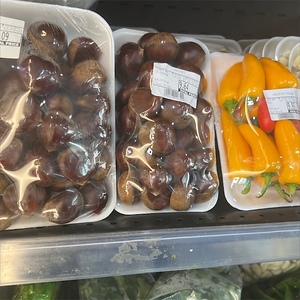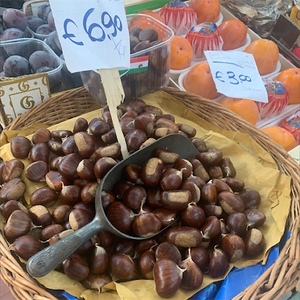


Fresh Chestnuts
Estimated Inventory, lb : 0
Description/Taste
Fresh Chestnuts are large, measuring approximately 3 centimeters in diameter, and have a bulbous, round, oval, to slightly ovate shape with one flat side. The nuts taper to a point at one end and have a thin, dark mahogany skin showcasing a glossy sheen. The surface also features textured striations extending the length of the nut with a light brown, semi-rough cap. Beneath the skin, the flesh ranges in color from beige to white and has a meaty, chewy, and starchy consistency. When raw, Chestnuts have a mild and semi-sweet flavor with a slight crunch. When cooked, the starches within the nut break down and turn creamy, developing a soft and tender consistency.
Seasons/Availability
Fresh Chestnuts are available in late fall through early winter.
Current Facts
Chestnuts are harvested from four main species, including the Japanese Chestnut, Castanea crenata, the Chinese Chestnut, Castanea mollissima, the American Chestnut, Castanea dentata, and the European Chestnut, Castanea sativa. Chestnuts grow in clusters on the large trees within spiny husks known as burrs. Depending on the species, each burr can contain between 1 and 7 nuts, which grow pressed against each other, resulting in each nut having at least one flattened side. Once the nuts have ripened, the burrs will split open and fall to the ground, where they are harvested, inspected for quality, and sorted. The quality of nuts can vary, but the best nuts are large and heavy with glossy skin that is easily removed. The highest quality Chestnuts are referred to as Marrons in France and other parts of Europe. Chestnut trees can live for 1,000 years and do not begin fruiting until they reach 40 years old. The name Chestnut is given to two other species of plants, water chestnuts, an aquatic vegetable unrelated to the Chestnut tree, and a poisonous tree nut with round, green, and spiky fruits known as horse chestnuts.
Nutritional Value
Fresh Chestnuts are nutritionally dense with relatively low-fat content. The nuts contain high amounts of dietary fiber and are a decent source of protein, a fuel source that helps repair bones, muscle, cartilage, and skin. The nuts are also a significant source of selenium, a critical mineral in thyroid and metabolism, and contain vitamin C, vitamin b6, manganese, potassium, and copper.
Applications
Fresh Chestnuts are popular in many different cuisines, including European, Asian, and American. Fresh Chestnuts can be enjoyed raw, but they are often cooked before they are eaten to produce a smoother consistency and sweeter flavor. The most iconic way of enjoying Chestnuts is to roast them over a fire or in the oven and enjoy them with butter. This technique has been immortalized in holiday songs and traditions in American and European households. When roasting Chestnuts, it is essential to score the nut's skin or cut them in half to allow steam to escape; otherwise, the nuts can explode while cooking. In Europe, Asia, and Africa, Chestnuts are substituted for potatoes in soups, stews, and braises. The nuts can be boiled or baked to soften and then mashed with butter. Puree the cooked nuts and add them to soups and sauces for a decadent nuttiness or slice them and add them to stuffing, pasta, and casseroles. Chestnuts can also be candied or used in desserts, like in the traditional Milanese dish monte bianco, where pureed Chestnuts are made into sweet pasta and served with chocolate and whipped cream. The nutty and mildly sweet flavor of Chestnuts pairs well with cruciferous veggies like Brussels sprouts, kale, and cabbage or with pork, poultry, and game meats. They are the perfect addition to hearty salads and grain dishes, and they complement maple syrup, chocolate, vanilla, and citrus. Fresh Chestnuts can spoil quickly due to their high-water content, so they should be stored in the refrigerator and used within two weeks. They can also be shelled and frozen to extend their shelf life up to six months.
Ethnic/Cultural Info
In the 15th century, settlers from the Northern region of Spain brought Chestnut tree saplings from the forests of Castille and Leon to the Western Sierras of the Andalucía Mountains. The temperate climate of this area was perfect for the trees, which flourished. Since that time, the Chestnut tree has played a vital role in the culture and economy of the region. Life in these villages, known as “Chestnut civilizations,” revolves around the planting, maintenance, and harvest of Chestnut trees. The solid and rot-resistant wood of the giant trees provides excellent lumber for building. This is apparent in the old house of the Sierra de Aracena, which feature beams, door frames, and window shutters made from Chestnut wood. The trees have split into many sub-varieties, each with its own trait like the Diego Vazquez, which features a darker and rounder nut, or the Camisaria, which has a smaller but sweeter nut. Chestnut production is vital to the Genal Valley, located on the Southern side of the mountain range. Chestnut harvest season is the busiest time of year in this region, with Chestnuts being the most important crop and primary source of income for farmers and small businesses. During the fall and winter holiday season, it's common to find people roasting chestnuts on street corners, serving them piping hot in a cornet made of old newspaper. Many wintery dishes feature the prized nut, including roasted meats, sauces, and confections, which are enjoyed during harvest festivals and holiday feasts in these small mountain villages.
Geography/History
DNA evidence shows that the original species of Castanea trees most likely originated in Eastern Asia before splitting into Chinese and Japanese varieties over 56 million years ago. The trees spread to Europe and North America a couple of million years later, where they naturalized, becoming their own sub-species. European Chestnuts were discovered by Ancient Greeks over 3,000 years ago near the Black Sea region of Southern Russia and were introduced to the Mediterranean region soon after. The Romans spread the trees into Northwest and Central Europe as they conquered the region. During the 15th century, settlers from Northern Spain began cultivating the trees in the Western Sierras of Andalucía, where they flourished. In North America, Chestnuts were a staple ingredient in the diets of indigenous tribes for thousands of years. European settlers also enjoyed American Chestnuts until the early 20th century, when an Asian blight fungus decimated the Chestnut tree population. Today, most of the Chestnuts sold in North America come from China, Korea, and Italy. The European Chestnut is the most commonly found species in Western markets, even though there is an American species. The American Chestnut tree used to cover much of the Eastern United States, but in 1904, a Japanese Chestnut tree carrying a fungus was planted in the Bronx Zoo. Over the next 40 years, this blight fungus decimated the American Chestnut tree population. Fresh Chestnuts can be found in specialty grocery stores during the winter months. They can also be found frozen at Asian markets and grocery stores worldwide.
Recipe Ideas
Recipes that include Fresh Chestnuts. One



